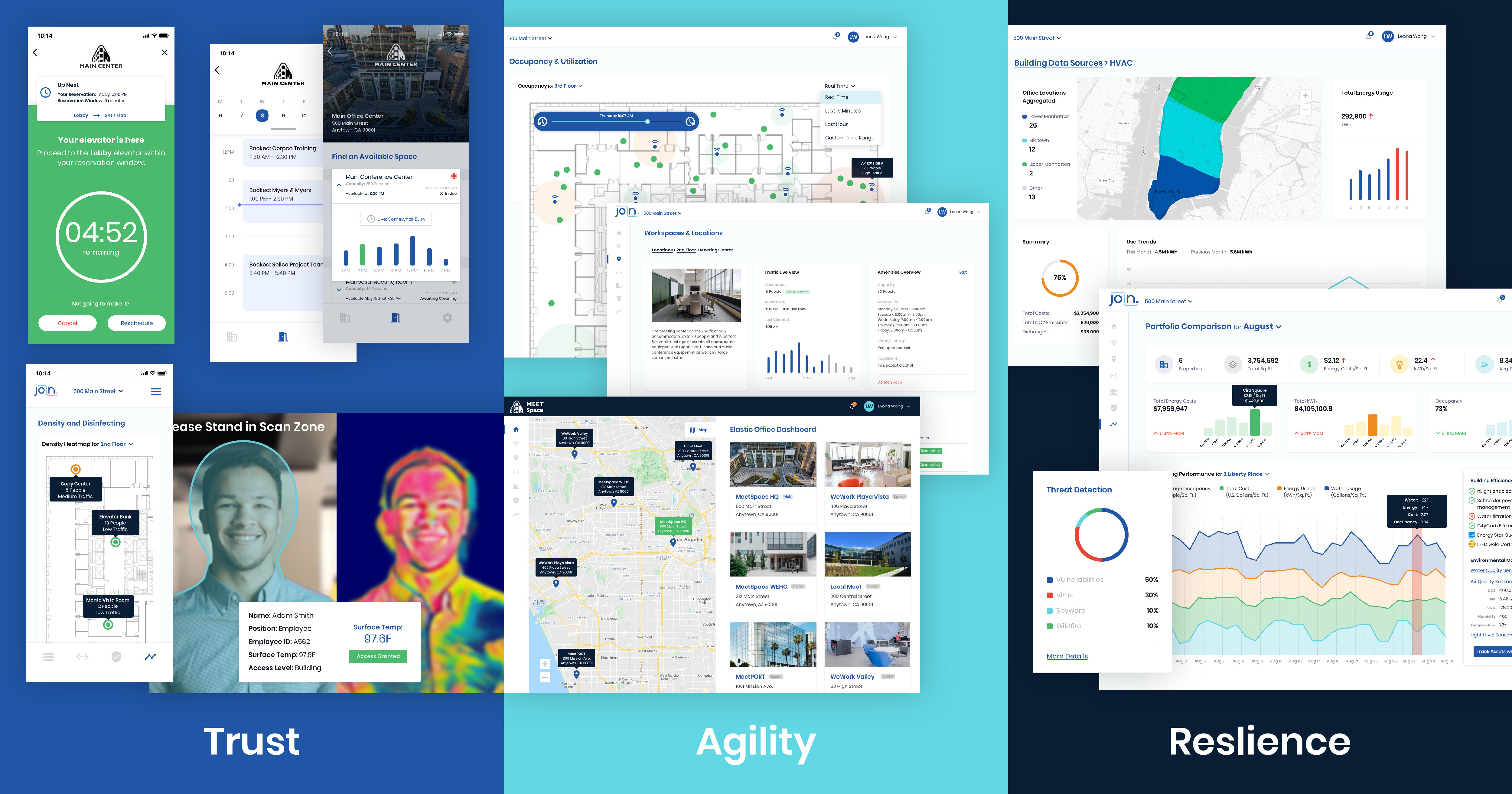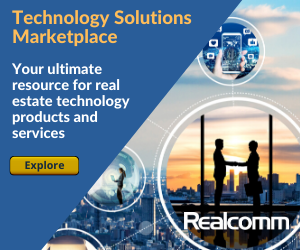The New Era of Workplace Connectivity

The challenge: decisiveness amid unrelenting uncertainty
In an environment that was already digitizing rapidly, COVID-19 creates a dynamic environment that mandates urgent and material innovation to solve a problem of very uncertain duration and evolution. Taking a page from how software developers use the cloud, the commercial real estate industry can take action now, adjust quickly and have better near- and long-term success.
Before COVID-19
Commercial offices were undergoing relentless change.
The nature of “knowledge work” in offices was increasingly digital and cloud-connected. Cybersecurity became ever more sophisticated to protect against rising attacks and data loss. Demand for co-working and shorter-term, more flexible leases was steadily rising; as much as 50% of new occupancy was in some form of flexible space. Building systems were increasingly connected to the cloud and producing data for analysis.
The motivation to make investments in buildings to adapt to these forces was, however, dependent on how well a building was positioned in its market. The stronger the demand for a given space, the more the owners could put the technology response to these forces onto the tenants and their IT departments. In most central business districts, demand was strong with prices generally rising.
The result is that digital systems in a large office building are islands of automation using redundant connections and patchwork security. Gaining visibility into patterns across these systems, let alone using data from these systems to power improved decisions and automation, remained a challenge beyond the reach of most companies.
Now with COVID-19
COVID-19 fast forwards digital for every building.
Cloud connected workers can work remotely and can modulate where they work based on their confidence in their safety and productivity. Security breaches, malware and data loss are not only more difficult to protect against with workers outside the main office, but now risks include complying with all new workplace density and cleaning requirements to make workers secure and data about their health private.
Demand for office space is now very difficult to understand and is nearly certainly softer. Employers that have survived have experienced radically new patterns of office usage and now need flexibility to discover the new normal. Long-term commitments in this climate that change weekly just don’t work.
To operate in such an uncertain environment, building owners, operators and employers need more visibility and insight into how people are using spaces to adjust and prioritize investments.
In our discussions with owners and operators around the country, the most urgent areas are coordinating smooth and secure access to the buildings; gaining much better visibility about when and how people are using buildings and amenities; and at the same time ensuring they can comply with privacy, cybersecurity and new density and cleaning reporting requirements.
Enter a new era of connectivity
Fortunately, the technology industry created an approach to rapid change and conditions of high uncertainty that are endemic to the software development industry, and today we call that the cloud. We are now in an era where cloud technologies and as-a-service business models enable the commercial office industry to move into digital fast forward to meet the dynamics of COVID-19 disruptions.
Secure connectivity is software defined and can be deployed and continuously upgraded dynamically. The secure digital connections also produce real-time data about space utilization and flow and can easily be combined with data such as cleaning schedules to ensure spaces meet density and cleaning standards.
Customers can subscribe to these capabilities as part of a flexible lease in flexible spaces without having to design, buy, maintain and upgrade their own complex collection of devices. Owners can understand how occupiers and operators are using the building services and create new services such as real-time coordination of flows up and down the elevators to improve confidence and productivity for the whole building.
These all start with superior connectivity and security. You add the ability to “sense” what is happening in the workplace and then provide that data to automate key activities.
Mandates for this era
This set of capabilities: Connect - Secure - Sense - Automate applies to fulfill three mandates on owners in this environment.
The first mandate is elevating trust. That is making workers feel informed, confident, and productive as they decide when to return to their workplaces.
The second you might call agile tenancy. The central idea is flexibility. Using lease innovations and digital technologies help owners and occupiers achieve greater flexibility in how they find and use workplaces to discover their new patterns for where they work.
The third is resilient operations. This mandate is to increase the productivity of building operators, i.e., those providing and operating building systems, sometimes doing so remotely.
Multiple real estate advisory and technology companies have recipes and toolkits to meet these mandates in the era of COVID-19, including Join. We launched our re-occupy toolkit this week.
After COVID-19
Having experienced digital on fast forward brought on by the pandemic, owners will be in a better position to understand and improve their properties and will have moved to a technology model that is much more agile and resilient to embrace all kinds of innovations after the pandemic has passed.
For example, applications that successfully elevate trust with workers in a building also create the pattern of workers engaging the building digitally. An application to coordinate socially distanced flows of people into the building during COVID-19 can turn into users being able to see and foresee when conference rooms, common areas and gyms will be uncongested, and perhaps even make reservations accordingly. Hence, they are enjoying more of the amenities that owners have invested in to draw and differentiate.
Another example are the dashboards that owners, operators and employers use during COVID-19 to understand the extent to which employees are returning to workplaces, for how long, to do which types of work, and to which parts of the facilities. These dashboards can enable an ongoing program of space reallocation and restructuring (from areas used less to areas used more) and be structured better for both larger and smaller group collaboration versus individual creative work.
We are, at least, months away from understanding the full impact of COVID-19 on work patterns, demand for office space, and the digital dashboards and applications that will enable successful operations on the other side.
But at Join, our point of view is that owners, operators and employers can respond to the near-term needs in ways that respond to COVID-19 mandates now, and at the same time create robust capabilities that will continue to add value in the future.
This Week’s Sponsor
Join delivers networking as-a-service to office owners and tenants to enable Smart Buildings and Smart Workplaces. Join’s Converged Network provides outstanding security and ultrafast connectivity to the internet with the ease-of-use of a modern cloud service. Join accelerates leasing by powering flexible space that creates great tenant experiences, transforms IT operations efficiency, and enables adoption of IoT and workplace technologies.
Read Next
 3/27/2025
3/27/2025
The Convergence of Edge Computing, Cloud, and AI in Building Automation and Smart Buildings In the built environment, we have seen the convergence of Operational Technology (OT) and Information Technology (IT), later expanding to include Workplace Technologies (WP).
 3/27/2025
3/27/2025
DC Power: A Holistic Approach to Energy Savings in Commercial Buildings In today's energy-conscious world, businesses constantly seek ways to reduce their carbon footprint and operational costs.
 3/13/2025
3/13/2025
How to Achieve Eco-Friendly Facility Management Commercial real estate operators and facility managers are focusing on sustainable practices to minimize environmental impact, create healthier workplaces, improve productivity and lower operational costs.
 1/23/2025
1/23/2025
When It Comes To Managing Properties’ Parking, Technology Is Key It’s easy for developers and real estate owners to think of parking as a necessary evil. They know they have to provide it (often, because it’s mandated by code), they understand that prospective tenants and buyers expect to be provided parking, but they haven’t figured out how to maximize its value.




.gif)







